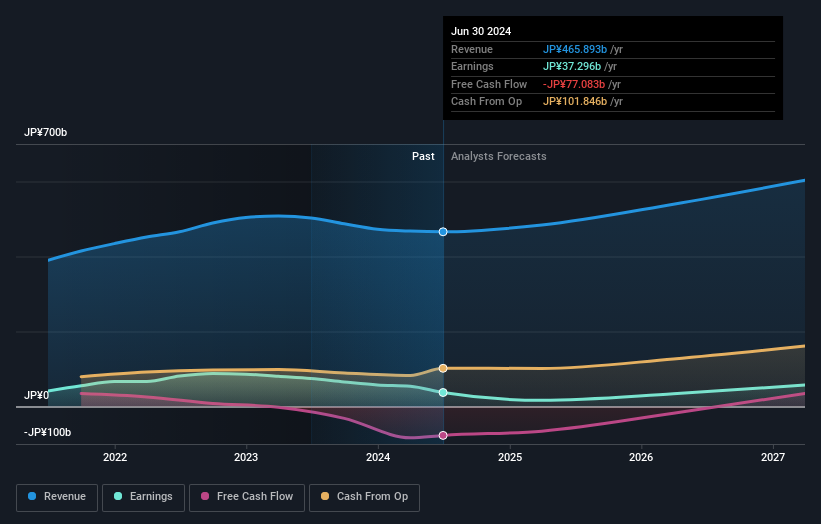- Japan
- /
- Semiconductors
- /
- TSE:6963
ROHM Co., Ltd. (TSE:6963) surges 5.6%; individual investors who own 52% shares profited along with institutions

Key Insights
- The considerable ownership by individual investors in ROHM indicates that they collectively have a greater say in management and business strategy
- 46% of the business is held by the top 25 shareholders
- Institutions own 48% of ROHM
Every investor in ROHM Co., Ltd. (TSE:6963) should be aware of the most powerful shareholder groups. And the group that holds the biggest piece of the pie are individual investors with 52% ownership. Put another way, the group faces the maximum upside potential (or downside risk).
While individual investors were the group that benefitted the most from last week’s JP¥36b market cap gain, institutions too had a 48% share in those profits.
Let's delve deeper into each type of owner of ROHM, beginning with the chart below.
Check out our latest analysis for ROHM

What Does The Institutional Ownership Tell Us About ROHM?
Many institutions measure their performance against an index that approximates the local market. So they usually pay more attention to companies that are included in major indices.
As you can see, institutional investors have a fair amount of stake in ROHM. This can indicate that the company has a certain degree of credibility in the investment community. However, it is best to be wary of relying on the supposed validation that comes with institutional investors. They too, get it wrong sometimes. If multiple institutions change their view on a stock at the same time, you could see the share price drop fast. It's therefore worth looking at ROHM's earnings history below. Of course, the future is what really matters.

Hedge funds don't have many shares in ROHM. Our data shows that Rohm Music Foundation, Endowment Arm is the largest shareholder with 11% of shares outstanding. Meanwhile, the second and third largest shareholders, hold 5.9% and 3.2%, of the shares outstanding, respectively.
Our studies suggest that the top 25 shareholders collectively control less than half of the company's shares, meaning that the company's shares are widely disseminated and there is no dominant shareholder.
While it makes sense to study institutional ownership data for a company, it also makes sense to study analyst sentiments to know which way the wind is blowing. There are a reasonable number of analysts covering the stock, so it might be useful to find out their aggregate view on the future.
Insider Ownership Of ROHM
While the precise definition of an insider can be subjective, almost everyone considers board members to be insiders. Management ultimately answers to the board. However, it is not uncommon for managers to be executive board members, especially if they are a founder or the CEO.
Most consider insider ownership a positive because it can indicate the board is well aligned with other shareholders. However, on some occasions too much power is concentrated within this group.
Our information suggests that ROHM Co., Ltd. insiders own under 1% of the company. Keep in mind that it's a big company, and the insiders own JP¥200m worth of shares. The absolute value might be more important than the proportional share. It is always good to see at least some insider ownership, but it might be worth checking if those insiders have been selling.
General Public Ownership
The general public, who are usually individual investors, hold a substantial 52% stake in ROHM, suggesting it is a fairly popular stock. With this amount of ownership, retail investors can collectively play a role in decisions that affect shareholder returns, such as dividend policies and the appointment of directors. They can also exercise the power to vote on acquisitions or mergers that may not improve profitability.
Next Steps:
It's always worth thinking about the different groups who own shares in a company. But to understand ROHM better, we need to consider many other factors. To that end, you should be aware of the 2 warning signs we've spotted with ROHM .
If you are like me, you may want to think about whether this company will grow or shrink. Luckily, you can check this free report showing analyst forecasts for its future.
NB: Figures in this article are calculated using data from the last twelve months, which refer to the 12-month period ending on the last date of the month the financial statement is dated. This may not be consistent with full year annual report figures.
New: AI Stock Screener & Alerts
Our new AI Stock Screener scans the market every day to uncover opportunities.
• Dividend Powerhouses (3%+ Yield)
• Undervalued Small Caps with Insider Buying
• High growth Tech and AI Companies
Or build your own from over 50 metrics.
Have feedback on this article? Concerned about the content? Get in touch with us directly. Alternatively, email editorial-team (at) simplywallst.com.
This article by Simply Wall St is general in nature. We provide commentary based on historical data and analyst forecasts only using an unbiased methodology and our articles are not intended to be financial advice. It does not constitute a recommendation to buy or sell any stock, and does not take account of your objectives, or your financial situation. We aim to bring you long-term focused analysis driven by fundamental data. Note that our analysis may not factor in the latest price-sensitive company announcements or qualitative material. Simply Wall St has no position in any stocks mentioned.
About TSE:6963
Reasonable growth potential with adequate balance sheet.
Similar Companies
Market Insights
Community Narratives




